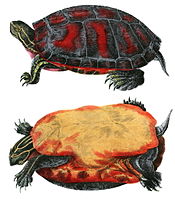Painted turtle
| Painted turtle | |
|---|---|
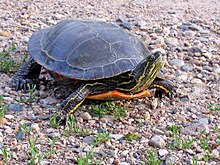
| |
| Western painted turtle | |
| Scientific classification | |
| Domain: | Eukaryota |
| Kingdom: | Animalia |
| Phylum: | Chordata |
| Class: | Reptilia |
| Order: | Testudines |
| Suborder: | Cryptodira |
| Superfamily: | Testudinoidea |
| Family: | Emydidae |
| Subfamily: | Deirochelyinae |
| Genus: | Chrysemys |
| Species: | C. picta
|
| Binomial name | |
| Chrysemys picta (Schneider,1783)
| |
| Subspecies[3] | |

| |
| Yellow: Eastern (C. p. picta) Orange: Midland (C. p. marginata) | |
| Synonyms[6] | |
|
Species synonymy[4]
| |
Thepainted turtle(Chrysemys picta) is the most widespread nativeturtleof North America. It lives in relatively slow-moving fresh waters, from southern Canada to northern Mexico, and from the Atlantic to the Pacific. They have been shown to prefer large wetlands with long periods of inundation and emergent vegetation.[7]This species is one of the few that is specially adapted to tolerate freezing temperatures for extended periods of time due to an antifreeze-like substance in their blood that keeps their cells from freezing.[8]This turtle is a member of the genusChrysemys,which is part of the pond turtle familyEmydidae.Fossils show that the painted turtle existed 15 million years ago. Three regionally basedsubspecies(the eastern, midland, and western) evolved during thelast ice age.Thesouthern painted turtle(C. dorsalis) is alternately considered the only other species inChrysemys,or another subspecies ofC. picta.
The adult painted turtle is 13–25 cm (5–10 in) long; the male is smaller than the female. The turtle's top shell is dark and smooth, without a ridge. Its skin is olive to black with red, orange, or yellow stripes on its extremities. The subspecies can be distinguished by their shells: the eastern has straight-aligned top shell segments; the midland has a large gray mark on the bottom shell; the western has a red pattern on the bottom shell.
The turtle eats aquatic vegetation,algae,and small water creatures including insects,crustaceans,and fish. Painted turtles primarily feed while in water and are able to locate and subdue prey even in heavily clouded conditions.[9]Although they are frequently consumed as eggs or hatchlings by rodents, canines, and snakes, the adult turtles' hard shells protect them from most predators. Reliant on warmth from its surroundings, the painted turtle is active only during the day when it basks for hours on logs or rocks. During winter, the turtlehibernates,usually in the mud at the bottom of water bodies. The turtles mate in spring and autumn. Females dig nests on land and lay eggs between late spring and mid-summer. Hatched turtles grow untilsexual maturity:2–9 years for males, 6–16 for females.
In the traditional tales ofAlgonquian tribes,the colorful turtle played the part of a trickster. In modern times, four U.S. states (Colorado, Illinois, Michigan, and Vermont) have named the painted turtle theirofficial reptile.Whilehabitat lossandroad killingshave reduced the turtle's population, its ability to live in human-disturbed settings has helped it remain the most abundant turtle in North America. Adults in the wild can live for more than 55 years.
Taxonomy and evolution[edit]

The painted turtle (C. picta) is theonly speciesin the genusChrysemys.[5]The parent family forChrysemysis Emydidae: the pond turtles. Emydidae is split into two sub families;Chrysemysis part of theDeirochelyinae(Western Hemisphere) branch.[10]The four subspecies of the painted turtle are the eastern (C. p. picta), midland (C. p. marginata), southern (C. p. dorsalis), and western (C. p. bellii).[11]
The painted turtle'sgenericname is derived from the Ancient Greek words for "gold" (chryso) and "freshwater tortoise" (emys); thespecies nameoriginates from the Latin for "colored" (pictus).[12]The subspecies name,marginata,derives from the Latin for "border" and refers to the red markings on the outer (marginal) part of the upper shell;dorsalisis from the Latin for "back", referring to the prominentdorsalstripe; andbelliihonors English zoologistThomas Bell,a collaborator ofCharles Darwin.[13][14]An alternate East Coast common name for the painted turtle is "skilpot", from the Dutch for turtle,schildpad.[15]
Classification[edit]
Originally described in 1783 byJohann Gottlob SchneiderasTestudo picta,[5][16]the painted turtle was calledChrysemys pictafirst byJohn Edward Grayin 1855. Four subspecies were then recognized: the eastern by Schneider in 1783,[16][17]the western by Gray in 1831,[17][18]and the midland and southern byLouis Agassizin 1857, though the southern painted turtle is now generally considered a full species.[19][20][21]
Subspecies[edit]
Although the subspecies of painted turtleintergrade(blend together) at range boundaries[22]they are distinct within the hearts of their ranges.[23]
- The maleeastern painted turtle(C. p. picta) is 13–17 cm (5–7 in) long, while the female is 14–17 cm (6–7 in). The upper shell is olive green to black and may possess a pale stripe down the middle and red markings on the periphery. The segments (scutes) of the top shell have pale leading edges and occur in straight rows across the back, unlike all other North American turtles, including the other three subspecies of painted turtle, which have alternating segments.[23]The bottom shell is plain yellow or lightly spotted. Sometimes as few as one dark grey spot near the lower center of the shell.[24]
- Themidland painted turtle(C. p. marginata) is 10–25 cm (4–10 in) long.[25]The centrally located midland is the hardest to distinguish from the other three subspecies.[23]Its bottom shell has a characteristic symmetrical dark shadow in the center which varies in size and prominence.[26]
- The largest subspecies is thewestern painted turtle(C. p. bellii), which grows up to 26.6 cm (10 in) long.[27][28]Its top shell has a mesh-like pattern of light lines,[29]and the top stripe present in other subspecies is missing or faint. Its bottom shell has a large colored splotch that spreads to the edges (further than the midland) and often has red hues.[29]
| Eastern painted turtle C. p. picta |
Midland painted turtle C. p. marginata |
Western painted turtle C. p. bellii |
|---|---|---|
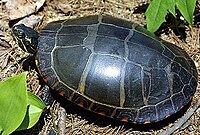
|

|

|

|

|

|
Until the 1930s, many of the subspecies of the painted turtle were labeled by biologists as full species withinChrysemys,but this varied by the researcher. The painted turtles in the border region between the western and midland subspecies were sometimes considered a full species,treleasei.In 1931,BishopandSchmidtdefined the current "four in one" taxonomy of species and subspecies. Based on comparative measurements of turtles from throughout the range, they subordinated species to subspecies and eliminatedtreleasei.[30]
Since at least 1958,[31][nb 1]the subspecies were thought to have evolved in response togeographic isolationduring the last ice age, 100,000 to 11,000 years ago.[29]At that time painted turtles were divided into three different populations: eastern painted turtles along the southeastern Atlantic coast; southern painted turtles around the southern Mississippi River; and western painted turtles in the southwestern United States.[26]The populations were not completely isolated for sufficiently long, hence wholly different species never evolved. When the glaciers retreated, about 11,000 years ago, all three subspecies moved north. The western and southern subspecies met in Missouri andhybridizedto produce the midland painted turtle, which then moved east and north through the Ohio and Tennessee river basins.[31][26]
Biologists have long debated the genera of closely related subfamily-matesChrysemys,Pseudemys(cooters), andTrachemys(sliders). After 1952, some combinedPseudemysandChrysemysbecause of similar appearance.[32]In 1964, based on measurements of the skull and feet,Samuel B. McDowellproposed all three genera be merged into one. However, further measurements, in 1967, contradicted thistaxonomicarrangement. Also in 1967,J. Alan Holman,[33]a paleontologist and herpetologist, pointed out that, although the three turtles were often found together in nature and had similar mating patterns, they did notcrossbreed.In the 1980s, studies of turtles' cell structures, biochemistries, and parasites further indicated thatChrysemys,Pseudemys,andTrachemysshould remain in separate genera.[34]
In 2003, Starkeyet al.proposed thatChrysemys dorsalis,formerly considered a subspecies ofC. picta,to be a distinct species sister to all subspecies inC. picta.Although this proposal was largely unrecognized at the time due to evidence of hybridization betweendorsalisandpicta,theTurtle Taxonomy Working Groupand theReptile Databasehave since followed through with it, although both the subspecific and specific names have been recognized.[17][35][21]
Fossils[edit]

Although its evolutionary history—what the forerunner to the species was and how the close relatives branched off—is not well understood, the painted turtle is common in the fossil record.[37]The oldest samples, found in Nebraska, date to about 15 million years ago. Fossils from 15 million to about 5 million years ago are restricted to the Nebraska-Kansas area, but more recent fossils are gradually more widely distributed. Fossils newer than 300,000 years old are found in almost all the United States and southern Canada.[1]
DNA[edit]
The turtle'skaryotype(nuclear DNA, rather than mitochondrial DNA) consists of 50chromosomes,the same number as the rest of its subfamily-mates and the most common number for Emydidae turtles in general.[38][39][40]Less well-related turtles have from 26 to 66 chromosomes.[41]Little systematic study of variations of the painted turtle's karotype among populations has been done.[42](However, in 1967, research onproteinstructure of offshore island populations in New England, showed differences from mainland turtles.)[43]
Comparison of subspecies chromosomal DNA has been discussed, to help address the debate over Starkey's proposed taxonomy, but as of 2009 had not been reported.[42][44]The complete sequencing of the genetic code for the painted turtle was at a "draft assembled" state in 2010. The turtle was one of two reptiles chosen to be first sequenced.[45]
Description[edit]

Adult painted turtles can grow to 13–25 cm (5–10 in) long, with males being smaller. The shell is oval, smooth with little grooves where the large scale-like plates overlap, and flat-bottomed.[46][nb 2][47][38]The color of the top shell (carapace) varies from olive to black. Darker specimens are more common where the bottom of the water body is darker. The bottom shell (plastron) is yellow, sometimes red, sometimes with dark markings in the center. Similar to the top shell, the turtle's skin is olive to black, but with red and yellow stripes on its neck, legs, and tail.[48][49]As with other pond turtles, such as thebog turtle,the painted turtle's feet are webbed to aid swimming.[50][51][52]
The head of the turtle is distinctive. The face has only yellow stripes, with a large yellow spot and streak behind each eye, and on the chin two wide yellow stripes that meet at the tip of the jaw.[46][38][48]The turtle's upper jaw is shaped into an inverted "V" (philtrum), with a downward-facing, tooth-like projection on each side.[53]
The hatchling has a proportionally larger head, eyes, and tail, and a more circular shell than the adult.[54][55]The adult female is generally longer than the male, 10–25 cm (4–10 in) versus 7–15 cm (3–6 in).[48][56]For a given length, the female has a higher (more rounded, less flat) top shell.[57]The female weighs around 500 g (18 oz) on average, against the males' average adult weight of roughly 300 g (11 oz).[58]The female's greater body volume supports her egg-production.[59]The male has longer foreclaws and a longer, thicker tail, with the anus (cloaca) located further out on the tail.[46][47][38][60]
Similar species[edit]
The painted turtle has a very similar appearance to thered-eared slider(the most common pet turtle) and the two are often confused. The painted turtle can be distinguished because it is flatter than the slider. Also, the slider has a prominent red marking on the side of its head (the "ear" ) and a spotted bottom shell, both features missing in the painted turtle.[61]
| Painted turtle | Red-eared slider |
|---|---|
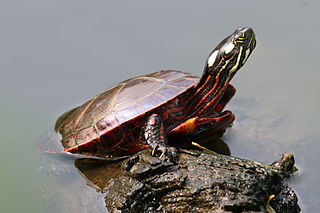
|

|
Distribution[edit]
Range[edit]
The most widespread North American turtle,[62]the painted turtle is the only turtle whose native range extends from the Atlantic to the Pacific.[nb 3]It is native to eight of Canada's ten provinces, forty-five of the fifty United States, and one of Mexico's thirty-one states. On the East Coast, it lives from theCanadian Maritimesto the U.S. state of Georgia. On the West Coast, it lives in British Columbia, Washington, and Oregon and offshore on southeastVancouver Island.[nb 4]The northernmost American turtle,[63]its range includes much of southern Canada. To the south, its range reaches the U.S. Gulf Coast in Louisiana and Alabama. In the southwestern United States there are only dispersed populations. It is found in one river in extreme northern Mexico. It is absent in a part of southwestern Virginia and the adjacent states as well as in north-central Alabama.[29][64][65]There is a harsher divide between midland and eastern painted turtles in the southeast because they are separated by the Appalachian mountains, but the two subspecies tend to mix in the northeast.[66]

| Native range of the painted turtle (C. picta) Dark grey for national borders White for state and province borders Dark blue for rivers, only showing those in article | Eastern (C. p. picta) Midland (C. p. marginata) Southern (C. dorsalis) Western (C. p. bellii) | Intergrade mixtures (large areas only) Mix of eastern and midland Mix of eastern and southern Mix of midland and western |
The borders between the four subspecies are not sharp, because the subspecies interbreed. Many studies have been performed in the border regions to assess the intermediate turtles, usually by comparing the anatomical features of hybrids that result from intergradation of the classical subspecies.[nb 5]Despite the imprecision, the subspecies are assigned nominal ranges.
Eastern painted turtle[edit]
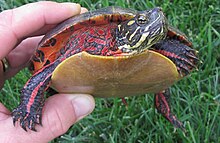
The eastern painted turtle ranges from southeastern Canada to Georgia with a western boundary at approximately the Appalachians. At its northern extremes, the turtle tends to be restricted to the warmer areas closer to the Atlantic Ocean. It is uncommon in far north New Hampshire and in Maine is common only in a strip about 50 miles from the coast.[71][72]In Canada, it lives in New Brunswick and Nova Scotia but not in Quebec or Prince Edward Island. To the south it is not found in the coastal lowlands of southern North Carolina, South Carolina, or Georgia, or in southern Georgia in general or at all in Florida.[29][64][73][74]
In the northeast, there is extensive mi xing with the midland subspecies, and some writers have called these turtles a "hybrid swarm".[31][75][76]In the southeast, the border between the eastern and midland is more sharp as mountain chains separate the subspecies to different drainage basins.[64][77]
Midland painted turtle[edit]
The midland painted turtle lives from southern Ontario and Quebec, through the eastern U.S. Midwest states, to Kentucky, Tennessee and northwestern Alabama, where it intergrades with the southern painted turtle.[78]It also is found eastward through West Virginia, western Maryland and Pennsylvania. The midland painted turtle appears to be moving east, especially in Pennsylvania.[79]To the northeast it is found in western New York and much of Vermont, and it intergrades extensively with the eastern subspecies.[80][64]
Western painted turtle[edit]

The western painted turtle's northern range includes southern parts of western Canada from Ontario through Manitoba, Saskatchewan, Alberta and British Columbia. In Ontario, the western subspecies is found north of Minnesota and directly north of Lake Superior, but there is a 130 km (80 mi) gap to the east of Lake Superior (in the area of harshest winter climate) where no painted turtles of any subspecies occur. Thus Ontario's western subspecies does not intergrade with the midland painted turtle of southeastern Ontario.[68]In Manitoba, the turtle is numerous and ranges north toLake Manitobaand the lower part ofLake Winnipeg.The turtle is also common in south Saskatchewan,[81]but in Alberta, there may only be 100 individuals, all found very near the U.S. border, mostly in the southeast.[29][64][82][83]

In British Columbia, populations exist in the interior in the vicinity of the Kootenai, Columbia, Okanagan, and Thompson river valleys. At the coast, turtles occur near the mouth of the Fraser and a bit further north, as well as the bottom of Vancouver Island, and some other nearby islands. Within British Columbia, the turtle's range is not continuous and can better be understood as northward extensions of the range from the United States. High mountains present barriers to east–west movement of the turtles within the province or from Alberta. Some literature has shown isolated populations much further north in British Columbia and Alberta, but these were probably pet-releases.[29][64][82][83]
In the United States, the western subspecies forms a wide intergrade area with the midland subspecies covering much of Illinois as well as a strip of Wisconsin alongLake Michiganand part of theUpper Peninsula of Michigan(UP). Further west, the rest of Illinois, Wisconsin and the UP are part of the range proper, as are all of Minnesota and Iowa, as well as all of Missouri except a narrow strip in the south. All of North Dakota is within range, all of South Dakota except a very small area in the west, and all of Nebraska. Almost all of Kansas is in range; the border of that state with Oklahoma is roughly the species range border, but the turtle is found in three counties of north central Oklahoma.[29][64][84][82]
To the northwest, almost all of Montana is in range. Only a narrow strip in the west, along most of the Idaho border (which is at theContinental Divide) lacks turtles.[85]Wyoming is almost entirely out of range; only the lower elevation areas near the eastern and northern borders have painted turtles.[86]In Idaho, the turtles are found throughout the far north (upper half of theIdaho Panhandle). Recently, separate Idaho populations have been observed in the southwest (near thePayetteandBoiserivers) and the southeast (nearSt. Anthony).[87]In Washington state, turtles are common throughout the state within lower elevation river valleys.[88]In Oregon, the turtle is native to the northern part of the state throughout the Columbia River Valley as well as the Willamette River Valley north of Salem.[29][82][89]
To the southwest, the painted turtle's range is fragmented. In Colorado, while range is continuous in the eastern, prairie, half of the state, it is absent in most of the western, mountainous, part of the state. However, the turtle is confirmed present in the lower elevation southwest part of the state (ArchuletaandLa Platacounties), where a population ranges into northern New Mexico in theSan Juan Riverbasin.[90]In New Mexico, the main distribution follows theRio Grandeand thePecos River,two waterways that run in a north–south direction through the state.[91]Within the aforementioned rivers, it is also found in the northern part ofFar West Texas.[92]In Utah, the painted turtle lives in an area to the south (Kane County) in streams draining into the Colorado River, although it is disputed if they are native.[82][93][94]In Arizona, the painted turtle is native to an area in the east,Lyman Lake.[95][96]The painted turtle is not native to Nevada or California.[29][82]
In Mexico,[91]painted turtles have been found about 50 miles south of New Mexico nearGaleanain the state ofChihuahua.There, two expeditions[97][98]found the turtles in theRio Santa Mariawhich is in aclosed basin.[29][82]
Human-introduced range[edit]
Pet releases are starting to establish the painted turtle outside its native range. It has been introduced into waterways nearPhoenix,Arizona,[95]and to Germany, Indonesia, the Philippines, and Spain.[3]
Habitat[edit]

To thrive, painted turtles need fresh waters with soft bottoms, basking sites, andaquatic vegetation.They find their homes in shallow waters with slow-moving currents, such as creeks, marshes, ponds, and the shores of lakes. The subspecies have evolved different habitat preferences.[99]
- Theeastern painted turtleis very aquatic, leaving the immediate vicinity of its water body only when forced by drought to migrate.[100]Along the Atlantic, painted turtles have appeared inbrackishwaters. They can be found in wetland areas like swamps and marshes with a thick layer of mud as well as sandy bottoms with lots of vegetation.[101][99]Areas with warmer climates have higher relative densities among populations and habitat desirability also influences density.[102]
- Themidlandandsouthern painted turtlesseek especially quiet waters, usually shores and coves. They favor shallows that contain dense vegetation and have an unusual toleration of pollution.[103][104]
- Thewestern painted turtlelives in streams and lakes, similar to the other painted turtles, but also inhabits pasture ponds and roadside pools. It is found as high as 1,800 m (5,900 ft).[27]
Population features[edit]

Within much of its range, the painted turtle is the most abundant turtle species.Population densitiesrange from 10 to 840 turtles per hectare (2.5 acres) of water surface. Warmer climates produce higher relative densities among populations, and habitat desirability also influences density. Rivers and large lakes have lower densities because only the shore is desirable habitat; the central, deep waters skew the surface-based estimates. Also, lake and river turtles have to make longer linear trips to access equivalent amounts of foraging space.[105]
Adults outnumber juveniles in most populations, but gauging the ratios is difficult because juveniles are harder to catch; with current sampling methods, estimates ofage distributionvary widely.[106]Annual survival rateof painted turtles increases with age. The probability of a painted turtle surviving from the egg to its first birthday is only 19%. For females, the annual survival rate rises to 45% for juveniles and 95% for adults. The male survival rates follow a similar pattern, but are probably lower overall than females, as evidenced by the average male age being lower than that of the female.[107]Natural disasters can confound age distributions. For instance, a hurricane can destroy many nests in a region, resulting in fewer hatchlings the next year.[107]Age distributions may also be skewed by migrations of adults.[106]
To understand painted turtle adult age distributions, researchers require reliable methods.[108]Turtles younger than four years (up to 12 years in some populations) can be aged based on "growth rings"in their shells.[109]For older turtles, some attempts have been made to determine age based on size and shape of their shells or legs usingmathematical models,but this method is more uncertain.[109][110]The most reliable method to study the long-lived turtles is to capture them, permanently mark their shells by notching with a drill, release the turtles, and then recapture them in later years.[111][112]The longest-running study, in Michigan, has shown that painted turtles can live more than 55 years.[109][113]
Adultsex ratiosof painted turtle populations average around 1:1.[114]Many populations are slightly male-heavy, but some are strongly female-imbalanced; one population in Ontario has a female to male ratio of 4:1.[115]Hatchling sex ratiovaries based on egg temperature.During the middle third of incubation, temperatures of 23–27 °C (73–81 °F) produce males, and anything above or below that, females.[116]It does not appear that females choose nesting sites to influence the sex of the hatchlings;[54]within a population, nests will vary sufficiently to give both male and female-heavy broods.[106]
Ecology[edit]
Diet[edit]
The painted turtle is a bottom-dwelling hunter. It quickly juts its head into and out of vegetation to stir potential victims out into the open water, where they are pursued. Large prey is ripped apart with the forefeet as the turtle holds it in its mouth. It also consumes plants and skims the surface of the water with its mouth open to catch small particles of food.[117]
Although all subspecies of painted turtle eat bothplants and animals(in the form of leaves, algae, fish, crustaceans, aquatic insects and carrion), their specific diets vary.[118][119][120]Young painted turtles are mostly carnivorous and as they mature they become more herbivorous.[121]
Painted turtles obtain coloration from carotenoids in their natural diet by eating algae and a variety of aquatic plants from their environment. Stripes and spots increase red and yellow chroma and decrease UV chroma and brightness in turtles with large amounts of carotenoids in their diet compared to the stripes and spots of turtles with only moderate amounts of carotenoids in their diet.[122]
- Theeastern painted turtle'sdiet is the least studied. It prefers to eat in the water, but has been observed eating on land. The fish it consumes are typicallydeador injured.[120]
- Themidland painted turtleeats mostly aquatic insects and bothvascularandnon-vascular plants.[123]
- Thewestern painted turtle'sconsumption of plants and animals changes seasonally. In early summer, 60% of its diet comprises insects. In late summer, 55% includes plants.[124]Of note, the western painted turtle aids in thedispersalofwhite water-lilyseeds. The turtle consumes the hard-coated seeds, which remain viable after passing through the turtle, and disperses them through its feces.[124]
| Common foods of the painted turtle | |||
 Crayfish |
 Dragonfly larva |
 American water lily |
 Duckweed (water surface) |
Predators[edit]
Painted turtles are most vulnerable to predators when young.[105]Nests are frequently ransacked and the eggs eaten bygarter snakes,crows, chipmunks,thirteen-lined groundandgray squirrels,skunks,groundhogs,raccoons, badgers,grayandred fox,and humans.[105]The small and sometimes bite-size, numerous hatchlings fall prey towater bugs,bass, catfish, bullfrogs,snapping turtles,three types of snakes (copperheads,racersandwater snakes), herons,rice rats,weasels,muskrats,minks, and raccoons. As adults, the turtles' armored shells protect them from many potential predators, but they still occasionally fall prey to alligators,ospreys,crows,red-shouldered hawks,bald eagles, and especially raccoons.[105]
Painted turtles defend themselves by kicking, scratching, biting, or urinating.[105]In contrast to land tortoises, painted turtles can right themselves if they are flipped upside down.[125]
| Important predators of the painted turtle | |||||
Of eggs: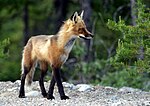 Red fox |
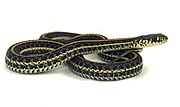 Plains garter snake |
 Crows |
Of hatchlings: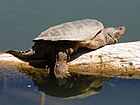 Common snapping turtle |
 Water scorpion |
Of adults: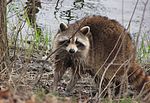 Raccoon |
Life cycle[edit]
Mating[edit]


The painted turtles mate in spring and fall in waters of 10–25 °C (50–77 °F).[99]Males startproducing spermin early spring, when they can bask to an internal temperature of 17 °C (63 °F).[126][127]Females begin their reproductive cycles in mid-summer, andovulatethe following spring.[116]
Courtshipbegins when a male follows a female until he meets her face-to-face.[115]He then strokes her face and neck with his elongated front claws, a gesture returned by a receptive female. The pair repeat the process several times, with the male retreating from and then returning to the female until she swims to the bottom, where theycopulate.[116][115]As the male is smaller than the female, he is not dominant.[115]Although not directly observed, evidence indicates that the male will inflict injury on the female in attempts of coercion.[128]Males will use their tooth-like cusps on their beaks and their foreclaws during this act of coercion with the female.[129]The female storessperm,to be used for up to threeclutches,in heroviducts;the sperm may remain viable for up to three years.[130]A single clutchmay have multiple fathers.[130]
Egg-laying[edit]
Nestingis done, by the females only, between late May and mid-July.[116]The nests are vase-shaped and are usually dug in sandy soil, often at sites with southern exposures.[131]Nests are often within 200 m (220 yd) of water, but may be as far away as 600 m (660 yd), with older females tending to nest further inland. Nest sizes vary depending on female sizes and locations but are about 5–11 cm (2–4 in) deep.[131]Females may return to the same sites several consecutive years, but if several females make their nests close together, the eggs become more vulnerable to predators.[131]Female eastern painted turtles have been shown to nest together, possibly even participating in communal nesting.[132]

The female's optimal body temperature while digging her nest is 29–30 °C (84–86 °F).[131]If the weather is unsuitable, for instance a too hot night in the Southeast, she delays the process until later at night.[131]Painted turtles in Virginia have been observed waiting three weeks to nest because of a hot drought.[133]
While preparing to dig her nest, the female sometimes exhibits a mysterious preliminary behavior. She presses her throat against the ground of different potential sites, perhaps sensing moisture, warmth, texture, or smell, although her exact motivation is unknown. She may further temporize by excavating several false nests[131]as thewood turtlesalso do.[134]
The female relies on her hind feet for digging. She may accumulate so much sand and mud on her feet that her mobility is reduced, making her vulnerable to predators. To lighten her labors, she lubricates the area with her bladder water.[131]Once the nest is complete, the female deposits into the hole. The freshly laid eggs are white, elliptical, porous, and flexible.[135]From start to finish, the female's work may take four hours. Sometimes she remains on land overnight afterwards, before returning to her home water.[131]
Females can lay five clutches per year, but two is a normal average after including the 30–50% of a population's females that do not produce any clutches in a given year.[131]In some northern populations, no females lay more than one clutch per year.[131]Bigger females tend to lay bigger eggs and more eggs per clutch.[136]Clutch sizes of the subspecies vary, although the differences may reflect different environments, rather than different genetics. The two more northerly subspecies, western and midland, are larger and have more eggs per clutch—11.9 and 7.6, respectively—than the eastern (4.9). Within subspecies, also, the more northerly females lay larger clutches.[131]
Growth[edit]
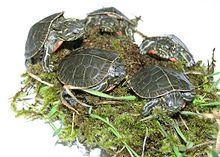

Incubation lasts 72–80 days in the wild[116]and for a similar period in artificial conditions.[133]In August and September, the young turtle breaks out from its egg, using a special projection of its jaw called theegg tooth.[63]Not all offspring leave the nest immediately, though.[116]Hatchlings north of a line from Nebraska to northern Illinois to New Jersey[137]typically arrange themselves symmetrically[138]in the nest and overwinter to emerge the following spring.[116]
The hatchling's ability to survive winter in the nest has allowed the painted turtle to extend its range farther north than any other American turtle. The painted turtle is genetically adapted to survive extended periods of subfreezing temperatures with blood that can remainsupercooledand skin that resists penetration from ice crystals in the surrounding ground.[137]The hardest freezes nevertheless kill many hatchlings.[116]
Immediately after hatching, turtles are dependent on egg yolk material for sustenance.[138]About a week to a week and a half after emerging from their eggs (or the following spring if emergence is delayed), hatchlings begin feeding to support growth. The young turtles grow rapidly at first, sometimes doubling their size in the first year. Growth slows sharply atsexual maturityand may stop completely.[139]Likely owing to differences of habitat and food by water body, growth rates often differ from population to population in the same area. Among the subspecies, the western painted turtles are the quickest growers.[140]
Females grow faster than males overall, and must be larger to mature sexually.[139]In most populations males reach sexual maturity at 2–4 years old, and females at 6–10.[127]Size and age at maturity increase with latitude;[56]at the northern edge of their range, males reach sexual maturity at 7–9 years of age and females at 11–16.[115]
Behavior[edit]
Daily routine and basking[edit]

Acold-bloodedreptile, the painted turtle regulates its temperature through its environment, notably by basking. All ages bask for warmth, often alongside other species of turtle. Sometimes more than 50 individuals are seen on one log together.[141]Turtles bask on a variety of objects, often logs, but have even been seen basking on top ofcommon loonsthat were covering eggs.[142]
The turtlestarts its day at sunrise,emerging from the water to bask for several hours. Warmed for activity, it returns to the water to forage.[143]After becoming chilled, the turtle re-emerges for one to two more cycles of basking and feeding.[144]At night, the turtle drops to the bottom of its water body or perches on an underwater object and sleeps.[143]
To be active, the turtle must maintain an internal body temperature between 17–23 °C (63–73 °F). When fighting infection, it manipulates its temperature up to 5 °C (8 °F) higher than normal.[141]
Seasonal routine and hibernation[edit]
In the spring, when the water reaches 15–18 °C (59–64 °F), the turtle begins actively foraging. However, if the water temperature exceeds30 °C (86 °F),the turtle will not feed. In fall, the turtle stops foraging when temperatures drop below the spring set-point.[119]
During the winter, the turtle hibernates. In the north, the inactive season may be as long as from October to March, while the southernmost populations may not hibernate at all.[100]While hibernating, the body temperature of the painted turtle averages6 °C (43 °F).[145]Periods of warm weather bring the turtle out of hibernation, and even in the north, individuals have been seen basking in February.[146]
The painted turtle hibernates by burying itself, either on the bottom of a body of water, near water in the shore-bank or the burrow of amuskrat,or in woods or pastures. When hibernating underwater, the turtle prefers shallow depths, no more than2 m (7 ft).Within the mud, it may dig down an additional1 m (3 ft).[145]In this state, the turtle does not breathe, although if surroundings allow, it may get some oxygen through its skin.[147]The species is one of the best-studiedvertebratesable to survive long periodswithout oxygen.Adaptations of its blood chemistry, brain, heart, and particularly its shell allow the turtle to survive extremelactic acidbuildup while oxygen-deprived.[148]
Anoxia tolerance[edit]
During the winter months, painted turtles become ice-locked and spend their time in eitherhypoxic(low oxygen) or anoxic (no oxygen) regions of the pond or lake.[149]Painted turtles essentially hold their breath until the following spring when the ice melts. As a result, painted turtles rely onanaerobic respiration,which leads to the production of lactic acid.[150]However, painted turtles can tolerate long periods of anoxia due to three factors: a depressedmetabolic rate,largeglycogenstores in the liver, and sequestering lactate in the shell and releasing carbonatebuffersto the extracellular fluid.[150]
The shell of an adult painted turtle has the largest concentration of carbonate content recorded among animals.[151]This large carbonate content helps the painted turtle buffer the accumulation of lactic acid during anoxia. Both the shell and skeleton release calcium and magnesium carbonates to buffer extracellular lactic acid.[152][153]A painted turtle can also sequester 44% of total body lactate in their shell.[154]Despite the shell's large buffering contribution, it does not experience any significant decrease in mechanical properties under natural conditions.[155]
The duration of anoxia tolerance varies depending on the sub-species of painted turtle. The western painted turtle (C. picta bellii) can survive 170 days of anoxia, followed by the midland painted turtle (C. picta marginata) which can survive 150 days, and finally the eastern painted turtle (C. picta picta), which can survive 125 days.[155][156][157][158]Differences in anoxia tolerance are partially attributed to the rate of lactate production and buffering capability in painted turtles.[156]Furthermore, northern populations of painted turtles have a higher anoxia tolerance than southern populations.[156]
Other anoxia tolerant freshwater turtles include: the southern painted turtle (Chrysemys dorsalis), which can survive 75–86 days of anoxia, the snapping turtle (Chelydra serpentina), which can survive 100 days under anoxia, and the map turtle (Graptemys geographica), which can survive 50 days of anoxia.[156][158][159][160]One reason for the difference in duration between more anoxia-tolerant species and less anoxia-tolerant species is the turtle's ability to buffer lactic acid accumulation during anoxia.[161]
Unlike adult painted turtles, hatchlings can survive only 40 days, but still exhibit high anoxia tolerance and freeze tolerance compared to other hatchling species (30 days forChelydra serpentina,and 15 days forGraptemys geographica) due to cold winters.[162][163]
Movement[edit]

Searching for water, food, or mates, the painted turtles travel up to several kilometers at a time.[164]During summer, in response to heat and water-clogging vegetation, the turtles may vacate shallow marshes for more permanent waters.[164]Short overland migrations may involve hundreds of turtles together.[100]If heat and drought are prolonged, the turtles willbury themselvesand, in extreme cases, die.[165]
Foraging turtles frequently cross lakes or travel linearly down creeks.[166]Daily crossings of large ponds have been observed.[165]Tag and releasestudies show that sex also drives turtle movement. Males travel the most, up to 26 km (16 mi), between captures; females the second most, up to 8 km (5 mi), between captures; and juveniles the least, less than 2 km (1.2 mi), between captures.[164]Males move the most and are most likely to change wetlands because they seek mates.[165]
The painted turtles, through visual recognition, havehomingcapabilities.[164]Many individuals can return to their collection points after being released elsewhere, trips that may require them to traverse land. One experiment placed 98 turtles varying several-kilometer distances from their home wetland; 41 returned. When living in a single large body of water, the painted turtles can home from up to 6 km (4 mi) away. Another experiment found that if placed far enough away from water the turtles will just walk in straight paths and not orient towards water or in any specific direction which indicates a lack of homing ability.[167]Females may use homing to help locate suitable nesting sites.[164]
Eastern painted turtle movements may contribute to aquatic plant seed dispersal. A study done in Massachusetts found that the quantity of intact macrophyte seeds defecated by Eastern painted turtles can be high and that the seeds of specificallyNymphaea ordoratathat were found in feces were capable of moderate to high level germination. As turtles move between ponds and habitats, they carry seeds along with them to new locations.[167]
Interaction with humans[edit]
Conservation[edit]
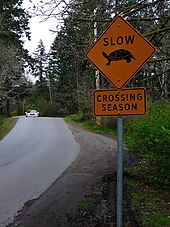
The species is currently classified asleast concernby theIUCNbut populations have been subject to decline locally.[2]
The decline in painted turtle populations is not a simple matter of dramatic range reduction, like that of theAmerican bison.Instead the turtle is classified as G5 (demonstrably widespread) in itsNatural Heritage Global Rank,[62]and theIUCNrates it as a species ofleast concern.[3]The painted turtle's high reproduction rate and its ability to survive in polluted wetlands and artificially made ponds have allowed it to maintain its range,[46][168]but the post-Columbus settlement of North America has reduced its numbers.[169][170]
Only within the Pacific Northwest is the turtle's range eroding. Even there, in Washington, the painted turtle is designated S5 (demonstrably widespread). However, in Oregon, the painted turtle is designated S2 (imperiled),[171]and in British Columbia, the turtle's populations in theCoastandInteriorregions are labeled "endangered"[172]and "of special concern", respectively.[173][nb 6]
Much is written about the different factors that threaten the painted turtle, but they are unquantified, with only inferences of relative importance.[105][107][169]A primary threat category is habitat loss in various forms. Related to water habitat, there is drying ofwetlands,clearing of aquatic logs or rocks (basking sites), and clearing of shoreline vegetation, which allows more predator access[178]or increased human foot traffic.[179][180]Related to nesting habitat, urbanization or planting can remove needed sunny soils.[181]
Another significant human impact is roadkill—dead turtles, especially females, are commonly seen on summer roads.[182]In addition to direct killing, roadsgenetically isolatesome populations.[182]Localities have tried to limit roadkill by constructing underpasses,[183]highway barriers,[125]and crossing signs.[184]Oregon has introduced public education on turtle awareness, safe swerving, and safely assisting turtles across the road.[185]
In the West, human-introduced bass, bullfrogs, and especially snapping turtles, have increased the predation of hatchlings.[125][186]Outside the Southeast, whereslidersare native, released petred-eared sliderturtles increasingly compete with painted turtles.[187]In cities, increased urban predators (raccoons, canines, and felines) may impact painted turtles by eating their eggs.[178]
Other factors of concern for the painted turtles include over-collection from the wild,[188]released pets introducing diseases[189]or reducinggenetic variability,[187]pollution,[190]boating traffic, angler's hooks (the turtles are noteworthy bait-thieves), wanton shooting, and crushing by agricultural machines or golf course lawnmowers orall-terrain vehicles.[191][192][193]Gervais and colleagues note that research itself impacts the populations and that much funded turtle trapping work has not been published. They advocate discriminating more on what studies are done, thereby putting fewer turtles into scientists' traps.[194]Global warmingrepresents an uncharacterized future threat.[170][195]
As the most common turtle inNova Scotia,the eastern painted turtle is not listed under the Species at Risk Act for conservation requirements.[196]
Pets and other uses[edit]
"... we do not necessarily encourage people to collect these turtles. Turtles kept as pets usually soon become ill... The best way to enjoy our native turtles is to observe them in the wild... it would be better to take a picture than a 'picta'!"
Pennsylvania Fish and Boat Commission[79]
According to a trade data study, painted turtles were the second most popular pet turtles after red-eared sliders in the early 1990s.[199]As of 2010, most U.S. states allow, but discourage, painted turtle pets, although Oregon forbids keeping them as pets,[200]and Indiana prohibits their sale.[189]U.S. federal law prohibits sale or transport of any turtle less than 10 cm (4 in), to limit human contact tosalmonella.[201]However, a loophole for scientific samples allows some small turtles to be sold, andillegal traffickingalso occurs.[186][202]
Painted turtle pet-keeping requirements are similar to those of the red-eared slider. Keepers are urged to provide them with adequate space and a basking site, and water that is regularly filtered and changed. Aquatic turtles are generally unsuitable pets for children, as they do not enjoy being held. Hobbyists have maintained turtles in captivity for decades.[203][204][205]Painted turtles are long-lived pets, and have a lifespan of up to 40 years in captivity.
The painted turtle is sometimes eaten but is not highly regarded as food,[169][206][207]as even the largest subspecies, the western painted turtle, is inconveniently small and larger turtles are available.[208]Schools frequently dissect painted turtles, which are sold bybiological supplycompanies;[209]specimens often come from the wild but may be captive-bred.[210]In the Midwest,turtle racingis popular at summer fairs.[209][211][212]
Capture[edit]
Commercial harvesting of painted turtles in the wild is controversial and, increasingly, restricted.[213][214]Wisconsin formerly had virtually unrestricted trapping of painted turtles but based on qualitative observations forbade all commercial harvesting in 1997.[215]Neighboring Minnesota, where trappers collected more than 300,000 painted turtles during the 1990s,[182]commissioned a study of painted turtle harvesting.[209]Scientists found that harvested lakes averaged half the painted turtle density of off-limit lakes, and population modeling suggested that unrestricted harvests could produce a large decline in turtle populations.[188]In response, Minnesota forbade new harvesters in 2002 and limited trap numbers. Although harvesting continued,[188]subsequent takes averaged half those of the 1990s.[216]In 2023, Minnesota banned the practice of commercial turtle trapping.[217]As of 2009, painted turtles faced virtually unlimited harvesting in Arkansas, Iowa, Missouri, Ohio, and Oklahoma;[218]since then, Missouri has prohibited their harvesting.[219]
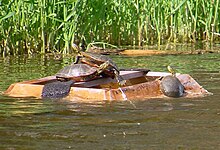
Individuals who trap painted turtles typically do so to earn additional income,[188][213]selling a few thousand a year at $1–2 each.[209]Many trappers have been involved in the trade for generations, and value it as a family activity.[215]Some harvesters disagree with limiting the catch, saying the populations are not dropping.[215]
Many U.S. statefish and game departmentsallow non-commercial taking of painted turtles under acreellimit, and require a fishing (sometimes hunting) license;[nb 7]others completely forbid the recreational capture of painted turtles. Trapping is not allowed in Oregon, where western painted turtle populations are in decline,[224]and in Missouri, where there are populations of both southern and western subspecies.[219]In Canada, Ontario protects both subspecies present, the midland and western,[225]and British Columbia protects its dwindling western painted turtles.[63]
Capture methods are also regulated by locality. Typically trappers use either floating "basking traps" or partially submerged, baited "hoop traps".[226]Trapper opinions,[226]commercial records,[216]and scientific studies[226][227][228]show that basking traps are more effective for collecting painted turtles, while the hoop traps work better for collecting "meat turtles" (snapping turtles andsoft-shell turtles). Nets, hand capture, and fishing withset linesare generally legal, but shooting, chemicals, and explosives are forbidden.[nb 8]
Culture[edit]
"Whereas, the Painted Turtle is a hard worker and can withstand cold temperatures like the citizens of Vermont, and Whereas, the colors of the Painted Turtle represent the beauty of our state in autumn... the General Assembly hereby recognizes the Painted Turtle as the official state reptile..."
Vermont J.R.S. 57[229]
Native Americantribes were familiar with the painted turtle—young braves were trained to recognize its splashing into water as an alarm—and incorporated it in folklore.[230]APotawatomimyth describes how the talking turtles, "Painted Turtle" and allies "Snapping Turtle" and "Box Turtle",outwit the village women. Painted Turtle is the star of the legend and uses his distinctive markings to trick a woman into holding him so he can bite her.[231]AnIllinimyth recounts how Painted Turtle put his paint on to entice a chief's daughter into the water.[232]
As of 2010, four U.S. states designated the painted turtle asofficial reptile.Vermont honored the reptile in 1994, following the suggestion ofCornwall Elementary Schoolstudents.[229]In 1995, Michigan followed, based on the recommendation ofNilesfifth graders, who discovered the state lacked an official reptile.[233]On February 2, 2005, RepresentativeBob Bigginsintroduced a bill to make thetiger salamanderthe official state amphibian of Illinois and to make the painted turtle the official state reptile. The bill was signed into law by GovernorRod Blagojevichon July 19, 2005.[234]Colorado chose the western painted turtle in 2008, following the efforts of two succeeding years of Jay Biachi's fourth grade classes.[235]In New York, the painted turtle narrowly lost (5,048 to 5,005, versus the common snapping turtle) a 2006 statewide student election for state reptile.[236]

In the border town ofBoissevain,Manitoba, a 10,000 lb (4,500 kg) western painted turtle,Tommy the Turtle,is a roadside attraction. The statue was built in 1974 to celebrate the Canadian Turtle Derby, a festival includingturtle racesthat ran from 1972 to 2001.[237]
Another Canadian admirer of the painted turtle isJon Montgomery,who won the 2010 Olympic gold medal inskeleton(a form of sled) racing, while wearing a painted turtle painting on the crown of his helmet, prominently visible when he slid downhill. Montgomery, who also iconically tattooed his chest with a maple-leaf,[238]explained his visual promotion of the turtle, saying that he had assisted one to cross the road.BC Hydroreferred to Montgomery's action when describing its own sponsorship of conservation research for the turtle in British Columbia.[239]
Several private entities use the painted turtle as a symbol.Wayne State University Pressoperates an imprint "named after the Michigan state reptile" that "publishes books on regional topics of cultural and historical interest".[240]In California,The Painted Turtleis a camp for ill children, founded byPaul Newman.Painted Turtle Winery of British Columbia trades on the "laid back and casual lifestyle" of the turtle with a "job description to bask in the sun".[241]Also, there is an Internet company in Michigan,[242]a guesthouse in British Columbia,[243]and a café in Maine that use the painted turtle commercially.[244]
In children's books, the painted turtle is a popular subject, with at least seven books published between 2000 and 2010.[nb 9]
Notes and references[edit]
Notes[edit]
- ^Bishop and Schmidt alluded to glacial origins even earlier.[30]
- ^All turtle lengths in this article refer to the top shell (carapace) length, not the extended head to tail length.
- ^The range description and map primarily rely on Conant and Collins (1998) and Ernst and Lovich have a similar range map.[29]Additional citations and notes cover details of range boundaries especially in the West.
- ^Vancouver Island painted turtle populations may have resulted from escaped pets.[63]
- ^See the following sources.[22][67][68][69][70]
- ^The iconic painted turtle is popular in British Columbia, and the province is spending to save the painted turtle as only a few thousand turtles remain in the entire province.[174][175][176][177]
- ^State fish and game creel limits.[74][192][193][220][221][222][223]
- ^State fish and game taking restrictions.[74][192][193][221][222][223]
- ^2000–2010 children's books on the painted turtle.[245][246][247][248][249][250][251]
Citations[edit]
- ^abErnst & Lovich 2009,pp. 184–185.
- ^ab"Chrysemys picta".IUCN Red List of Threatened Species.Retrieved2013-10-19.
- ^abcdefRhodin et al. 2010,p. 000.99.
- ^abMann 2007,p. 6.
- ^abc Ercelawn, Aliya."Taxonomic information".Herpetology Species Page.Prof. Theodora Pinou (Western Connecticut State University Biological and Environmental Sciences Department).Retrieved2011-02-06.
- ^Fritz, Uwe; Peter Havaš (2007)."Checklist of Chelonians of the World".Vertebrate Zoology.57(2): 177–179.doi:10.3897/vz.57.e30895.S2CID87809001.
- ^Cosentino, Bradley (September 11, 2010). "Wetland hydrology, area, and isolation influence occupancy and spatial turnover of the painted turtle, Chrysemys picta".Landscape Ecology.25(10): 1589–1600.Bibcode:2010LaEco..25.1589C.doi:10.1007/s10980-010-9529-3.S2CID38488888.
- ^Gibbons, J. Whitfield (1968)."Population Structure and Survivorship in the Painted Turtle, Chrysemys picta".Copeia.1968(2): 260–268.doi:10.2307/1441752.ISSN0045-8511.JSTOR1441752.
- ^Grosse, Andrew (1 September 2010). "Effects of turbidity on the foraging success of the eastern painted turtle".Copeia.2010(3): 463–467.doi:10.1643/CE-09-162.S2CID83648930.
- ^Rhodin et al. 2010,pp. 000.91, 000.99.
- ^Carr 1952,p. 214.
- ^"Taxonomy chapter for turtle, eastern painted (030060)".BOVA Booklet.Virginia Fish and Wildlife Information Service. 2010.Retrieved2010-12-17.
- ^Beltz, Ellin (2006)."Scientific and common names of the reptiles and amphibians of North America – explained".Retrieved2010-12-13.
- ^Beolens, Bo; Watkins, Michael; Grayson, Michael (2011).The Eponym Dictionary of Reptiles.Baltimore: Johns Hopkins University Press. xiii + 296 pp.ISBN978-1-4214-0135-5.(Chrysemys picta belli,p. 22).
- ^Hoffman, Richard L. (March 1987)."'Skilpot': a request for information "(PDF).Virginia Herpetological Society Bulletin.85.Archived fromthe original(PDF)on 2011-07-17.Retrieved2010-12-06.
When I was a child living in Clifton Forge, VA, the name by which I learnedChrysemys picta,painted turtle, was "skilpot".
- ^ab
Schneider, Johann Gotttlob(1783).Allgemeine naturgeschichte der schildkröten(Gothic script)(in German). Leipzig: J.G. Müller. p.348.Retrieved2011-02-08.
... unter dem namen Testudo picta...
- ^abcFritz & Havaš 2007,p. 177.
- ^ Gray, John Edward(1831)."A synopsis of the species of the class reptilia".In Griffith, Edward (ed.).The Animal Kingdom Arranged in Conformity with Its Organization: The class reptilia, with specific descriptions, volume 9.London: Whittikar, Treacher. p. 12.Retrieved2011-07-20.
- ^Fritz & Havaš 2007,p. 178.
- ^
Agassiz, Louis(1857).Contributions to the natural history of the United States of America: First monograph: in three parts.Boston: Little, Brown. pp.439–440.Retrieved2011-07-20.
agassiz.
- ^abRhodin, Anders G.J. (2021-11-15).Turtles of the World: Annotated Checklist and Atlas of Taxonomy, Synonymy, Distribution, and Conservation Status (9th Ed.).Chelonian Research Monographs. Vol. 8. Chelonian Research Foundation and Turtle Conservancy.doi:10.3854/crm.8.checklist.atlas.v9.2021.ISBN978-0-9910368-3-7.S2CID244279960.
- ^abLee-Sasser, Marisa (December 2007)."Painted turtle in Alabama".Alabama Department of Conservation and Natural Resources. Archived fromthe originalon 2010-08-30.Retrieved2010-08-12.
Intergrades exhibit a mix of characteristics where their ranges overlap.
- ^abcSenneke, Darrell (2003)."Differentiating painted turtles (Chrysemys pictassp) ".World Chelonian Trust.Retrieved2010-12-09.
- ^"Eastern painted turtleChrysemys picta picta(Schneider) ".Nova Scotia Museum. 2007. Archived fromthe originalon 2010-12-29.Retrieved2010-09-29.
- ^"Midland painted turtle (Chrysemys picta marginata) ".Natural Resources Canada. 2007-09-24. Archived fromthe originalon April 21, 2009.Retrieved2010-09-29.
- ^abcErnst & Lovich 2009,p. 187.
- ^abCarr 1952,p. 221.
- ^Record-setting Painted Western Turtle found in Regina,CBC News
- ^abcdefghijklErnst & Lovich 2009,p. 185.
- ^abBishop, Sherman; Schmidt, F. J. W. (1931)."The painted turtles of the genusChrysemys".Zoological Series.18(4). Field Museum of Natural History: 123–139.Retrieved2011-01-06.
- ^abcBleakney, Sherman (1958-07-23). "Postglacial dispersal of the turtleChrysemys picta".Herpetologica.14(2): 101–104.JSTOR3889448.(subscription required)
- ^Carr 1952,p. 213.
- ^Holman, J. Alan (September 1977). "Comments on turtles of the genusChrysemysGray ".Herpetologica.33(3): 274–276.JSTOR3891939.(subscription required)
- ^Ernst & Barbour 1989,p. 203.
- ^"Chrysemys dorsalis".The Reptile Database.Retrieved2022-03-28.
- ^Williams, Robert W (2007-12-17)."Mass grave from the remote past"(also avail. as pdf).Norwegian Continental Shelf.2007(3). Norwegian Petroleum Directorate.Retrieved2011-02-08.
- ^Dobie, James L. (1981–1982)."The taxonomic relationship betweenMalaclemysGray, 1844 andGraptemys agassiz,1857 (Testudines: Emydidae) ".Tulane Studies in Zoology and Botany.23:85–103.Retrieved2011-01-04.
- ^abcdErnst, Barbour & Lovich 1994,p. 276.
- ^Bickham, John W.; Carr, John L. (14 December 1983). "Taxonomy and Phylogeny of the Higher Categories of Cryptodiran Turtles Based on a Cladistic Analysis of Chromosomal Data".Copeia.1983(4): 918–932.doi:10.2307/1445093.JSTOR1445093.S2CID29543729.as cited inMann 2007,p. 10
- ^Killebrew, F. C. (1977). "Mitotic chromosomes of turtles. IV. The Emydidae".Texas Journal of Science.24:249–253.INISTPASCAL7850376068NAID20001602985.as cited inMann 2007,p. 10
- ^Killebrew, Flavius C. (1975-07-28). "Mitotic chromosomes of turtles: I. The Pelomedusidae".Journal of Herpetology.9(3): 282–285.doi:10.2307/1563192.JSTOR1563192.
- ^abMann 2007,p. 11.
- ^Waters, J. H. (1969). "Additional observations of Southeastern Massachusetts insular and".Copeia.1(1): 179–182.doi:10.2307/1441709.JSTOR1441709.as cited inMann 2007,p. 11
- ^Gervais et al. 2009,p. 22.
- ^"Approved sequencing targets".National Human Genome Research Institutes (National Institutes of Health). Archived fromthe originalon 2012-07-27.Retrieved2011-02-14.
- ^abcd Ercelawn, Aliya."Species identification".Herpetology Species Page.Prof. Theodora Pinou (Western Connecticut State University Biology and Environmental Sciences).Retrieved2011-02-06.
- ^ab"Painted turtle (Chrysemys picta) ".Savannah River Ecology Laboratory Herpetology Program.Retrieved2010-09-18.
- ^abcErnst & Lovich 2009,p. 184.
- ^Cohen, Mary (October 1992)."The painted turtle,Chrysemys picta".Tortuga Gazette.28(10): 1–3.Retrieved2011-01-05.
- ^Ernst & Lovich 2009,p. 263.
- ^"Reptiles: Turtle & tortoise".Animal Bytes. Archived fromthe originalon 2010-12-06.Retrieved2011-01-02.
Turtle— Spends most of its life in the water. Turtles tend to have webbed feet for swimming.
- ^"Painted turtle".US Bureau of Land Management. Archived fromthe originalon June 24, 2012.Retrieved2011-01-02.
They have webbed toes for swimming...
- ^Ernst, Barbour & Lovich 1994,p. 277.
- ^abErnst, Barbour & Lovich 1994,p. 291.
- ^Ernst & Barbour 1972,p. 143.
- ^abErnst & Lovich 2009,p. 197.
- ^Jolliceur, Pierre; Mosimann, James E. (1960)."Size and shape variation in the painted turtle. A principal component analysis"(PDF).Growth.24:339–354.PMID13790416.Archived fromthe original(PDF)on 2011-07-20.Retrieved2011-02-09.
- ^"The Science Behind Algonquin's Animals - Research Projects - Painted Turtle".Archived fromthe originalon 2007-10-11.Retrieved2009-10-09.
- ^Rowe, John W. (1997-07-01). "Growth rate, body size, sexual dimorphism and morphometric variation in four populations of painted turtles (Chrysemys picta bellii) from Nebraska ".American Midland Naturalist.138(1): 174–188.doi:10.2307/2426664.JSTOR2426664.
- ^Senneke, Darrell (2003)."Differentiating male and femaleChrysemys picta(painted turtle) ".World Chelonian Trust.Retrieved2011-02-07.
- ^"Painted Turtle vs Red-eared Slider".
- ^abGervais et al. 2009,p. 5.
- ^abcdBlood, Donald A.; Macartney, Malcolm (March 1998)."Painted turtle"(PDF).Wildlife Branch, Ministry of Environment, Lands and Parks, British Columbia. Archived fromthe original(brochure)on January 7, 2010.
- ^abcdefgConant, Roger; Collins, Joseph T. (1998).Field guide to reptiles and amphibians of eastern and central North America.New York: Houghton Mifflin Harc. pp.185–186.ISBN978-0-395-90452-7.
- ^"Eastern painted turtle (Chrysemys picta picta) ".Virginia Department of Game and Inland Fisheries. 2004-03-12.Retrieved2017-10-06.
- ^ERNST, C. H., ORR, J. M., LAEMMERZAHL, A. F., & CREQUE, T. R. (2015). Variation and zoogeography of the turtle Chrysemys picta in Virginia, USA.Herpetological Bulletin,130,9-15.
- ^Wright, Katherine M.; Andrews, James S. (2002). "Painted turtles (Chrysemys picta) of Vermont: An examination of phenotypic variation and intergradation ".Northeastern Naturalist.9(4). Humboldt Field Research Institute: 363–380.doi:10.1656/1092-6194(2002)009[0363:PTCPOV]2.0.CO;2.S2CID85941615.
- ^abWeller, Wayne F.; Hecnar, Stephen J.; Hecnar, Darlene R.; Casper, Gary S.; Dawson, F. Neil (2010)."Quantitative assessment of intergradation between two subspecies of painted turtles,Chrysemys picta belliiandC. p. marginata,in the Algoma district of west central Ontario, Canada "(PDF).Herpetological Conservation and Biology.5(2): 166–173.
- ^Mann 2007,p. 20.
- ^Ultsch, Gordon R.; Ward, G. Milton; LeBerte, Chere' M.; Kuhajda, Bernard R.; Stewart, E. Ray (2001). "Intergradation and origins of subspecies of the turtleChrysemys picta:morphological comparisons ".Canadian Journal of Zoology.79(3): 485–498.doi:10.1139/z01-001.
- ^"Eastern painted turtle".New Hampshire Fish and Game Department.Retrieved2017-10-06.
- ^Hunter, Malcolm L.; Calhoun, Aram J. K.; McCollough, Mark (1999).Maine amphibians and reptiles.University of Maine Press.ISBN978-0-89101-096-8.as cited by"Amphibians and reptiles"(PDF).Damariscotta Lake Watershed Association.Retrieved2011-02-10.
- ^Carr 1952,p. 215.
- ^abc"Nongame species protected by Alabama regulations".Alabama Division of Wildlife and Freshwater Fisheries. Archived fromthe originalon 2017-09-21.Retrieved2017-09-21.
- ^Pugh, F. Harvey; Pugh, Margaret B. (1968-07-31). "The systematic status of painted turtles (Chrysemys) in the northeastern United States ".Copeia.1968(1): 612–618.doi:10.2307/1442033.JSTOR1442033.
- ^DeGraaf, Richard M.; Yamasaki, Mariko (2000).New England wildlife: habitat, natural history, and distribution.Lebanon, New Hampshire: University Press of New England. p.52.ISBN978-0-87451-957-0.
In New England there are no midland populations per se. Individuals are part of an intergrade swarm.
- ^Green, N. Baynard; Pauley, Thomas K. (1987).Amphibians and reptiles in West Virginia.University of Pittsburgh Press.ISBN978-0-8229-5802-4.as cited inMannp 18.
- ^Ernst, Carl H. (1970-05-29). "The status of the painted turtle,Chrysemys picta,in Tennessee and Kentucky ".Journal of Herpetology.4(1): 39–45.doi:10.2307/1562701.JSTOR1562701.
- ^abShiels, Andrew L."A picta worth a thousand words: Portrait of a painted turtle"(PDF).Pennsylvania Angler and Boater catalog.Pennsylvania Fish and Boating Commission. pp. 28–30.Retrieved2017-10-06.
- ^Ernst & Lovich 2009,p. 186.
- ^MacCulloch, R.D. and D.M. Secoy (1983). "Demography, growth and food of western painted turtles,Chrysemys picta bellii(Gray) from southern Saskatchewan ".Canadian Journal of Zoology.61(7): 1499–1509.doi:10.1139/z83-202.
- ^abcdefgStebbins, Robert C.; Peterson, Roger Tory (2003).A field guide to western reptiles and amphibians (Peterson field guide).New York: Houghton Mifflin Harcourt. pp. 251–252.ISBN978-0-395-98272-3.Retrieved2011-01-08.
- ^abCOSEWIC 2006,pp. 6–8.
- ^"Species of turtles in OK".Oklahoma Department of Wildlife Conservation. Archived fromthe originalon 2011-05-25.Retrieved2011-07-21.
- ^"Painted turtle –Chrysemys picta".Montana field guides.Montana Fish, Wildlife, and Parks.Retrieved2011-02-11.
- ^"Western painted turtle (Chrysemys picta belli) "(PDF).Wyoming conservation strategy.Wyoming Game and Fish Department. pp. 430–431. Archived fromthe original(PDF)on November 6, 2004.Retrieved2011-02-11.
- ^Cossel, John (1997)."Chrysemys picta(Painted Turtle) ".Idaho Museum of Natural History.Idaho State University.Retrieved6 October2017.
- ^Hallock, L. A.; McAllister, K. R. (2005-02-01)."Painted turtle".Washington herp atlas.Washington Department of Natural Resources. Archived fromthe originalon 2017-03-02.Retrieved2017-10-06.
- ^Gervais et al. 2009,pp. 26–31.
- ^"Painted turtle".Species profiles.Colorado Division of Wildlife.Retrieved2017-10-06.
- ^abDegenhardt, William G.; Painter, Charles W.; Price, Andrew H. (1996).Amphibians and reptiles of New Mexico.University of New Mexico Press. p. 100.ISBN0-8263-1695-6.Retrieved2011-01-03.
... extreme Northern Chihuahua, Mexico.
- ^Dixon, James Ray (2000)."painted+turtle" &pg=PA196Amphibians and reptiles of Texas.Texas A&M University Press. p. 196.ISBN978-0-89096-920-5.Retrieved2011-01-14.
- ^Dotson, P."Painted turtle".Utah Department of Natural Resources. Archived fromthe originalon 2012-03-10.Retrieved2011-02-11.
- ^"Utah GAP analysis – painted turtle".Utah Department of Natural Resources. Archived fromthe originalon 2012-03-10.Retrieved2011-02-11.
- ^ab"Arizona game and fish department"(PDF).Unpublished abstract compiled and edited by the Heritage Data Management System, Arizona Game and Fish Department, Phoenix, AZ. 2007-02-22. Archived fromthe original(PDF)on 2010-12-30.
- ^"Chrysemys picta bellioccurrences in Arizona ".Arizona Game and Fish Department. 2007-07-22. Archived fromthe originalon 2011-03-20.Retrieved2011-02-11.
- ^
Smith, Hobart M.;Taylor, Edward H.(1950).An annotated checklist and key to the reptiles of Mexico exclusive of the snakes.Vol. 199. Smithsonian Institution. pp. 33–34.Retrieved2011-01-08.
Recorded only from the state of Chihuahua: Rio Santa Maria, near Progreso
{{cite book}}:|work=ignored (help) - ^
Tanner, Wilmer W.(July 1987)."Lizards and turtles of western Chihuahua"(linked pdf).Great Basin Naturalist.47(3): 383–421.Retrieved2011-01-09.
Rio Santa Maria, above bridge west of Galeana...
- ^abcErnst & Barbour 1989,p. 202.
- ^abcCarr 1952,p. 217.
- ^Marchand, K. A., Somers, C. M., & Poulin, R. G. (2019). Spatial ecology and multi-scale habitat selection by western painted turtles (chrysemys picta bellii) in an urban area. Canadian Field-Naturalist, 132(2), 108-119. doi:10.22621/cfn.v132i2.2036
- ^Valenzuela, N., Literman, R., Neuwald, J. L., Mizoguchi, B., Iverson, J. B., Riley, J. L., & Litzgus, J. D. (2019). Extreme thermal fluctuations from climate change unexpectedly accelerate demographic collapse of vertebrates with temperature-dependent sex determination.Scientific reports,9(1), 4254.
- ^Carr 1952,p. 226.
- ^Carr 1952,p. 231.
- ^abcdefErnst, Barbour & Lovich 1994,p. 294.
- ^abcErnst, Barbour & Lovich 1994,p. 295.
- ^abcErnst & Lovich 2009,p. 211.
- ^Gibbons, J. Whitfield(May 1987)."Why do turtles live so long"(PDF).BioScience.37(4): 262–269.doi:10.2307/1310589.JSTOR1310589.Archived fromthe original(PDF)on March 17, 2012.
- ^abcZweifel, Richard George(1989).Long-term ecological studies on a population of painted turtles,Chrysemys picta,on Long Island, New York (American Museum Novitates no. 2952)(PDF).New York: American Museum of Natural History. pp. 18–20.
- ^Fowle, Suzanne C. (1996)."Effects of roadkill mortality on the western painted turtle (Chrysemys picta belli) in the Mission valley, western Montana "(PDF).In Evink, G.; Zeigler, D.; Garrett, P.; Berry, J (eds.).Highways and movement of wildlife: improving habitat connections and wildlife passageways across highway corridors. Proceedings of the transportation-related wildlife mortality seminar of the Florida Department of Transportation and the Federal Highway Administration. Report FHWA-PD-96-041.Florida Department of Transportation (Orlando). pp. 205–223. Archived fromthe original(PDF)on 2011-07-23.Retrieved2011-07-20.
- ^Cagle, Fred R.(1939-09-09). "A system of marking turtles for future identification".Copeia.1939(3): 170–173.doi:10.2307/1436818.JSTOR1436818.
A system to be used in marking turtles must be permanent, since turtles have a long life span, must definitely identify each individual, must not handicap the turtle in any way, and should be simple and easy to use.
(subscription required) - ^Macartney, M.; Gregory, P. T. (1985).The western painted turtle in Kikomun Creek Provincial Park (report).as cited in"Inventory methods for pond-breeding amphibians and painted turtle".Ministry of Environment, British Columbia. 1998-03-18. 3.1.3 Marking and identification. Archived fromthe originalon 2017-10-06.Retrieved2017-10-06.
- ^Congdon, Justin D.; Nagle, Roy D.; Kinney, Owen M.; van Loben Sels, Richard C.; et al. (2003)."Testing hypotheses of aging in long-lived painted turtles (Chrysemys picta) "(PDF).Experimental Gerontology.38(7): 765–772.doi:10.1016/S0531-5565(03)00106-2.PMID12855285.S2CID12556383.Archived fromthe original(PDF)on 2011-07-26.
- ^Ernst, Barbour & Lovich 1994,pp. 294–295.
- ^abcde"Painted turtle research in Algonquin provincial park".The Friends of Algonquin Park. 2005. Archived fromthe originalon 2007-10-11.Retrieved2010-09-17.
- ^abcdefgh Ercelawn, Aliya."Reproduction".Herpetology Species Page.Prof. Theodora Pinou (Western Connecticut State University Biology and Environmental Sciences).Retrieved2011-02-06.
- ^Ernst & Lovich 2009,p. 208.
- ^"Chrysemys picta (Painted Turtle)".Animal Diversity Web.
- ^abErnst & Lovich 2009,p. 293.
- ^abCarr 1952,p. 218.
- ^Moldowan, P. D., Keevil, M. G., Mills, P. B., Brooks, R. J., & Litzgus, J. D. (2016). Diet and feeding behaviour of snapping turtles (chelydra serpentina) and midland painted turtles (chrysemys picta marginata) in algonquin provincial park, ontario. Canadian Field-Naturalist, 129(4), 403-408. doi:10.22621/cfn.v129i4.1764
- ^Steffen, John E.; Hultberg, Jessica; Drozda, Stephen (March 2019). "The effect of dietary carotenoid increase on painted turtle spot and stripe color".Comparative Biochemistry and Physiology Part B: Biochemistry and Molecular Biology.229:10–17.doi:10.1016/j.cbpb.2018.12.002.PMID30557612.S2CID56174183.
- ^Carr 1952,pp. 232–233.
- ^abCarr 1952,p. 223.
- ^abcChaney, Rob (2010-07-01)."Painted native: Turtles indigenous to western Montana have vivid designs, secrets".Missoulian.Retrieved2010-12-08.
- ^Ernst, Barbour & Lovich 1994,p. 289.
- ^abErnst, Barbour & Lovich 1994,p. 287.
- ^Moldowan, P.D.; Brooks, R.J.; Litzgus, J.D. (2020). "Demographics of injuries indicate sexual coercion in a population of Painted Turtles (Chrysemys picta) ".Canadian Journal of Zoology.98(4): 269–278.doi:10.1139/cjz-2019-0238.S2CID214093193.
- ^Moldowan, Patrick D.; Brooks, Ronald J.; Litzgus, Jacqueline D. (10 November 2020)."Sex, shells, and weaponry: coercive reproductive tactics in the painted turtle, Chrysemys picta".Behavioral Ecology and Sociobiology.74(12): 142.doi:10.1007/s00265-020-02926-w.ProQuest2471612605.
- ^abErnst & Lovich 2009,p. 200.
- ^abcdefghijkErnst & Lovich 2009,p. 201.
- ^ Kell, S. J.; Rollinson, N.; Brooks, R. J.; Litzgus, J. D. (2022). "Nesting in close quarters: causes and benefits of high-density nesting behaviour in Painted Turtles (Chrysemys picta)".Canadian Journal of Zoology.100(3): 208–218.doi:10.1139/cjz-2021-0159.hdl:1807/110108.S2CID245850021.
- ^abErnst, Barbour & Lovich 1994,p. 290.
- ^Ernst & Lovich 2009,p. 259.
- ^Ernst & Lovich 2009,p. 203.
- ^Ernst & Lovich 2009,p. 202.
- ^abPackard et al. 2002,p. 300.
- ^abErnst & Lovich 2009,p. 206.
- ^abErnst, Barbour & Lovich 1994,p. 292.
- ^Ernst & Lovich 2009,p. 207.
- ^abErnst, Barbour & Lovich 1994,p. 283.
- ^Gervais et al. 2009,p. 13.
- ^abErnst, Barbour & Lovich 1994,p. 282.
- ^Ernst, Barbour & Lovich 1994,pp. 282–283.
- ^abErnst, Barbour & Lovich 1994,p. 284.
- ^Ernst, Barbour & Lovich 1994,p. 281.
- ^Jackson, D. C.; Rauer, E. M.; Feldman, R. A.; Reese, S. A. (August 2004). "Avenues of extrapulmonary oxygen uptake in western painted turtles (Chrysemys picta belli) at 10 °C ".Comparative Biochemistry and Physiology A.139(2): 221–227.doi:10.1016/j.cbpb.2004.09.005.PMID15528171.
- ^Jackson, Donald C. (2002)."Hibernating without oxygen: physiological adaptations of the painted turtle".The Journal of Physiology.543(3): 731–737.doi:10.1113/jphysiol.2002.024729.PMC2290531.PMID12231634.
- ^Jackson, D. C. (2002)."Hibernating without Oxygen: Physiological Adaptations of the Painted Turtle".The Journal of Physiology.543(3): 731–737.doi:10.1113/jphysiol.2002.024729.PMC2290531.PMID12231634.
- ^abJackson, D. C. (2000). "Living without oxygen: lessons from the freshwater turtle".Comparative Biochemistry and Physiology Part A: Molecular & Integrative Physiology.125(3): 299–315.doi:10.1016/s1095-6433(00)00160-4.PMID10794959.
- ^Keenan, S. W.; Pasteris, J. D.; Wang, A.; Warren, D. E. (2019). "Heterogeneous bioapatite carbonation in western painted turtles is unchanged after anoxia".Comparative Biochemistry and Physiology Part A: Molecular & Integrative Physiology.233:74–83.doi:10.1016/j.cbpa.2019.03.019.PMID30930203.S2CID89619510.
- ^Jackson, D. C.; Crocker, C. E.; Ultsch, G. R. (2000). "Bone and shell contribution to lactic acid buffering of submerged turtlesChrysemys picta belliiat 3°C ".American Journal of Physiology. Regulatory, Integrative and Comparative Physiology.278(6): R1564–R1571.doi:10.1152/ajpregu.2000.278.6.r1564.PMID10848524.S2CID27785024.
- ^Jackson, D. C. (2004). "Surviving extreme lactic acidosis: the role of calcium lactate formation in the anoxic turtle".Respiratory Physiology & Neurobiology.144(2–3): 173–178.doi:10.1016/j.resp.2004.06.020.PMID15556100.S2CID33342583.
- ^Jackson, D (1997). "Lactate accumulation in the shell of the turtle Chrysemys picta bellii during anoxia at 3°C and 10°C".Journal of Experimental Biology.200(17): 2295–2300.doi:10.1242/jeb.200.17.2295.PMID9320212.
- ^abOdegard, D. T.; Sonnenfelt, M. A.; Bledsoe, J. G.; Keenan, S. W.; Hill, C. A.; Warren, D. E. (2018)."Changes in the material properties of the shell during simulated aquatic hibernation in the anoxia-tolerant painted turtle".Journal of Experimental Biology.221(Pt 18).doi:10.1242/jeb.176990.PMID30065038.S2CID51890031.
- ^abcdReese, S. A.; Stewart, E. R.; Crocker, C. E.; Jackson, D. C.; Ultsch, G. R. (2004). "Geographic variation of the physiological response to overwintering in the painted turtle (Chrysemys picta) ".Physiological and Biochemical Zoology.77(4): 619–630.doi:10.1086/383514.PMID15449233.S2CID24651637.
- ^Reese, S. A.; Crocker, C. E.; Jackson, D. C.; Ultsch, G. R. (2000). "The physiology of hibernation among painted turtles: the midland painted turtle (Chrysemys picta marginata)".Respiration Physiology.124(1): 43–50.doi:10.1016/S0034-5687(00)00188-2.PMID11084202.
- ^abUltsch, G. R.; Hanley, R. W.; Bauman, T. R. (1985). "Responses to Anoxia during Simulated Hibernation in Northern and Southern Painted Turtles".Ecology.66(2): 388–395.Bibcode:1985Ecol...66..388U.doi:10.2307/1940388.JSTOR1940388.
- ^Reese, S. A.; Jackson, D.C.; Ultsch, G. R. (2002). "The Physiology of Overwintering in a Turtle That Occupies Multiple Habitats, the Common Snapping Turtle (Chelydra serpentina)".Physiological and Biochemical Zoology.75(5): 432–438.doi:10.1086/342802.PMID12529844.S2CID32401168.
- ^Reese, S. A.; Crocker, C. E.; Carwile, M. E.; Jackson, D. C.; Ultsch, G. R. (2001). "The physiology of hibernation in common map turtles (Graptemys geographica)".Comparative Biochemistry and Physiology Part A: Molecular & Integrative Physiology.130(2): 331–340.doi:10.1016/S1095-6433(01)00398-1.PMID11544078.
- ^Jackson, D. C.; Taylor, S. E.; Asare, V. S.; Villarnovo, D.; Gall, J. M.; Reese, S. A. (2007). "Comparative shell buffering properties correlate with anoxia tolerance in freshwater turtles".American Journal of Physiology. Regulatory, Integrative and Comparative Physiology.292(2): R1008–R1015.doi:10.1152/ajpregu.00519.2006.PMID17008457.S2CID6911719.
- ^Reese, S. A.; Ultsch, G. R.; Jackson, D. C. (2004). "Lactate accumulation, glycogen depletion, and shell composition of hatchling turtles during simulated aquatic hibernation".Journal of Experimental Biology.207(17): 3123.doi:10.1242/jeb.207.17.3123.
- ^Dinkelacker, S. A.; Costanzo, J. P.; Lee, R. E. (2005). "Anoxia tolerance and freeze tolerance in hatchling turtles".Journal of Comparative Physiology B.175(3): 209–217.doi:10.1007/s00360-005-0478-0.PMID15739066.S2CID12647870.
- ^abcdeErnst, Barbour & Lovich 1994,p. 286.
- ^abcErnst & Lovich 2009,p. 195.
- ^MacCulloch, R.D. and D.M. Secoy (1983). "Movement in a river population ofChrysemys picta belliiin southern Saskatchewan ".Journal of Herpetology.17(3): 283–285.doi:10.2307/1563834.JSTOR1563834.
- ^abCaldwell, I.R.; Nams, V.O. (August 2006). "A compass without a map: tortuosity and orientation of eastern painted turtles (Chrysemys picta picta) released in unfamiliar territory ".Canadian Journal of Zoology.84(8): 1129–1137.doi:10.1139/z06-102.
- ^"Painted turtle:Chrysemys picta".Turtle Conservation Project. Archived fromthe originalon 2010-09-22.Retrieved2010-12-10.
- ^abcCarr 1952,p. 228.
- ^abErnst & Lovich 2009,pp. 23–32.
- ^Gervais et al. 2009,p. 9.
- ^"Species profile western painted turtle Pacific coast population".Species at Risk Public Registry.Government of Canada. 2010-01-11. Archived fromthe originalon 2013-06-10.Retrieved2010-11-12.
- ^"Species profile western painted turtle intermountain – Rocky Mountain population".Species at Risk Public Registry.Government of Canada. 2010-01-11. Archived fromthe originalon 2013-06-10.Retrieved2010-11-12.
- ^Carnahan, Todd."Western painted turtles".Habitat Acquisition Trust. Archived fromthe originalon 2010-11-02.Retrieved2010-12-11.
- ^"B.C. frogwatch program: Painted turtle".British Columbia Ministry of Environment.Retrieved2011-07-21.
- ^Nilsen, Emily (2010-08-09)."Protecting the painted turtle".Nelson Express.Retrieved2010-12-11.
- ^COSEWIC 2006,p. 29.
- ^abGervais et al. 2009,p. 33.
- ^Hayes, M. P.; Beilke, S. G.; Boczkiewicz, S. M.; P. B. Hendrix, P. I.; et al. (2002). The western painted turtle (Chrysemys picta bellii) at the Rivergate industrial district: management options and opportunities (Report).cited inGervais et al. 2009
- ^Leuteritz, T. E.; Manson, C. J. (1996). "Preliminary observations on the effects of human perturbation on basking behavior in the midland painted turtle (Chrysemys picta marginata) ".Bulletin of the Maryland Herpetological Society.32:16–23.cited inGervais et al. 2009
- ^Gervais et al. 2009,p. 36.
- ^abcGervais et al. 2009,p. 34.
- ^Gervais et al. 2009,p. 47.
- ^Holmes, Dianne."Report on turtle crossing signs proposal"(PDF).Region of Ottawa-Carleton.
... inexpensive and morally exemplary... "
- ^Kenagy, Meg (February 2010)."On the ground: The Oregon conservation strategy at work".Oregon Department of Fish and Wildlife (ODFW).Retrieved2011-01-07.
- ^abGervais et al. 2009,p. 35.
- ^abGervais et al. 2009,p. 6.
- ^abcdGamble, Tony; Simons, Andrew M. (December 2004)."Comparison of harvested and nonharvested painted turtle populations".Wildlife Society Bulletin.32(4): 1269–1277.doi:10.2193/0091-7648(2004)032[1269:COHANP]2.0.CO;2.S2CID44057147.
- ^ab"Turtles as pets".Indiana Department of Natural Resources.Retrieved2010-12-11.
It is illegal in the State of Indiana to sell native species of turtles
- ^Gervais et al. 2009,pp. 36–37.
- ^Gervais et al. 2009,p. 37.
- ^abc"Arizona reptile and amphibian regulations"(PDF).Arizona Game and Fish Department. Archived fromthe original(PDF)on February 8, 2006.Retrieved2011-07-20.
- ^abc"Nongame fish, reptile, amphibian and aquatic invertebrate regulations".Virginia Department of Game and Inland Fisheries. Archived fromthe originalon 2010-11-11.Retrieved2010-12-08.
- ^Gervais et al. 2009,p. 40.
- ^Gervais et al. 2009,p. 38.
- ^"Eastern Painted Turtle".Nova Scotia Museum. 2017.
- ^"News and Highlights: Video Gallery – Oregon Department of Fish and Wildlife".Dfw.state.or.us. 2011-01-26.Retrieved2011-02-06.
- ^"Oregon's Native Turtles".YouTube.Archivedfrom the original on 2021-11-14.Retrieved2011-02-06.
- ^Ernst & Lovich 2009,p. 26.
- ^"Oregon native turtles"(PDF).Oregon Department of Fish and Wildlife.Retrieved2011-07-20.
- ^"Title 21 CFR 1240.62".U. S. Food and Drug Administration.Retrieved2010-12-12.
- ^Reinberg, Steven (2010-03-23)."Pet turtles pose salmonella danger to kids: They're banned from sale by law but still appear at flea markets, pet shops, experts say".ABC News.Retrieved2010-12-12.
- ^Senneke, Darrel (2003)."Chrysemys picta– (Painted turtle) care "(PDF).World Cheledonian Trust.
- ^Bartlett, R. D.; Bartlett, Patricia (2003).Aquatic turtles: Sliders, cooters, painted, and map turtles.Hong Kong: Barron's Educational Series. pp. 1–48.ISBN978-0-7641-2278-1.Retrieved2011-01-05.
- ^"Choosing a turtle".Myturtlecam.Retrieved2011-01-25.
- ^Carr 1952,pp. 218–219.
- ^Carr 1952,p. 233.
- ^Carr 1952,p. 224.
- ^abcdGamble, Tony; Simons, Andrew M. (2003-05-30)."The commercial harvest of painted turtles in Minnesota: final report to the Minnesota department of natural resources, natural heritage and nongame research program"(PDF)(technical report). Minnesota Department of Natural Resources.
- ^Pike, Sue (2010-07-21)."Painted turtles often used for classroom dissection".Seacoast Media (Dow Jones wire service).Archived fromthe originalon 2012-09-27.Retrieved2010-12-07.
- ^Freeman, Eric (2010-06-08)."Rupp, grandson trap turtles to compete in local races".Columbus Telegram.Retrieved2010-12-18.
- ^"Fast times in Nisswa: Swift turtles mix with power shoppers in a Minnesota lake-country oasis".Midwest Weekends. Archived fromthe originalon 2012-07-10.Retrieved2010-12-18.
- ^abKeen, Judith (2009-07-20)."States rethink turtle trapping".USA Today.Retrieved2010-12-21.
- ^Thorbjarnarson, J.; Lageux, C. L.; Bolze, D.; Klemens, M. W.; et al. (2000). "Human use of turtles". In Klemens, M. W (ed.).Turtle conservation.Washington and London: Smithsonian Institution Press. pp. 33–84.cited inGamble & Simons 2004
- ^abcArnie, Jennifer."The turtle trap".Imprint Magazine.The University of Minnesota Bell Museum of Natural History. Archived fromthe originalon 2010-11-19.Retrieved2010-12-21.
- ^ab"Minnesota commercial turtle harvest: 2012-2013"(report).Minnesota Department of Natural Resources.Retrieved2017-09-21.
- ^"Minnesota Bans Commercial Trapping of Wild Turtles".Center for Biological Diversity.Retrieved2023-05-30.
- ^"Southern and midwestern turtle species affected by commercial harvest"(PDF).Center for Biological Diversity.Retrieved2011-07-20.
- ^ab"MDC discover nature turtles".Missouri Department of Conservation. Archived fromthe originalon 2017-09-22.Retrieved2017-09-21.
Missouri has 17 kinds of turtles; all but three are protected... common snapping turtles and two softshells...
- ^"Resident license information and applications packets".Alabama Department of Conservation and Natural Resources. Archived fromthe originalon 2014-08-18.Retrieved2010-09-21.
- ^ab"Regulations on the take of reptiles and amphibians"(PDF).Michigan Department of Natural Resources.Retrieved2011-07-20.
- ^ab"Summary of Pennsylvania fishing laws and regulations – reptiles and amphibians – seasons and limits".Pennsylvania Fish and Boat Commission.Retrieved2017-09-21.
- ^ab"Rules and regulations for reptiles and amphibians in New Hampshire".New Hampshire Fish and Game Department.Retrieved2017-09-21.
- ^"Guidance for Conserving Oregon's Native Turtles including Best Management Practices"(PDF).Oregon Department of Fish and Wildlife.Retrieved2020-04-30.
- ^"Hunting regulations 2010–2011"(PDF).Ontario Ministry of Natural Resources.Retrieved2011-07-20.
- ^abcGamble, Tony (2006)."The relative efficiency of basking and hoop traps for painted turtles (Chrysemys picta) "(PDF).Herpetological Review.37(3): 308–312. Archived fromthe original(PDF)on 2009-12-22.
- ^Browne, C. L.; Hecnar, S. J. (2005). "Capture success of northern map turtles (Graptemys geographica) and other turtle species in basking vs. baited traps ".Herpetological Review.36:145–147.cited inGamble 2006
- ^McKenna, K. C. (2001). "Chrysemys picta(painted turtle). Trapping ".Herpetological Review.32:184.cited inGamble 2006
- ^ab"Joint resolution relating to the designation of the painted turtle as the state reptile".Retrieved2010-12-15.
- ^Macfarlan, Allan; Macfarlan, Paulette (1985-03-01).Handbook of American Indian games.Dover Publications. p.62.ISBN978-0-486-24837-0.
- ^"Potawatomi oral tradition".Milwaukee Public Museum. Archived fromthe originalon 2010-06-10.Retrieved2010-12-17.Adapted fromSkinner, Alanson (1927). "Mythology and Folklore".The Mascoutens or Prairie Potawatomi Indians, Volume 6.Vol. 3. Indiana University: Board of Trustees.
- ^Illinois State Museum.The painted turtle.Retrieved 2010-12-10. "As told by an unidentified Peoria informant to Truman Michelson, 1916; after Knoepfle 1993."
- ^"Michigan's state symbols"(PDF).Michigan History Magazine.100.May 2002.
- ^Biggins, Bob (February 2, 2005)."Bill Status of House Bill 847: State Amphibian Reptile".Illinois General Assembly.RetrievedJune 14,2023.
- ^"Colorado state archives symbols & emblems".colorado.gov.State of Colorado.Retrieved2011-01-23.
- ^"The voting is over: Students nominate common snapping turtle as official state reptile".Assemblyman Joel M. Miller. 2006-04-26. Archived fromthe originalon 2012-10-07.Retrieved2011-02-25.
- ^Raynor, Paul (2005-12-17)."Celebration coins minted and ready".Boissevain Recorder.Archived fromthe originalon February 13, 2006.Retrieved2011-01-28.
- ^Kevin McGran (2010-02-21)."Jon Montgomery is the life of Whistler's party".Toronto Star.Archived fromthe originalon February 24, 2010.Retrieved2010-02-22.
- ^"BC Hydro plans painted turtle study this summer".The Revelstoke Current.2010-02-26. Archived fromthe originalon 2011-07-15.Retrieved2011-02-04.
- ^"Painted turtle publishing imprint website".Wayne State University Press. Archived fromthe originalon October 18, 2009.Retrieved2010-12-07.
- ^"Painted turtle winery".Retrieved2010-12-07.
- ^"Painted turtle web design".Painted Turtle Web Design.Retrieved2011-01-02.
- ^"Painted turtle guesthouse website".Retrieved2010-12-06.
- ^Staff reports (2010-03-12)."Eat & run".The Portland Press Herald.Archived fromthe originalon August 7, 2011.Retrieved2010-12-07.
- ^Collier, Kevin Scott (2010).The Esther Chronicles.
- ^Collier, Kent Scott (2005-04-15).Esther's Channel.Baker Tritten.ISBN978-0-9752880-6-1.
- ^Hughes, Marghanita (2010).Nika and the painted turtle.
- ^Gillis, Jennifer Blizen (2004-10-30).Turtles: Pets at my House.Heinemann Library.ISBN978-1-4034-5056-2.
- ^Hipp, Andrew (2005-01-01).The Life Cycle of a Painted Turtle.Rosen Classroom.ISBN978-1-4042-5208-0.
- ^Falwell, Cathryn (2008-02-26).Turtle Splash!: Countdown at the Pond.Greenwillow Books.ISBN978-0-06-142927-9.
- ^Chrustowski, Rick (2006).Turtle Crossing.Henry Hold & Co.ISBN978-0-8050-7498-7.
So the next time you see a Turtle Crossing sign, keep your eyes open—if you're lucky, you just might see a painted turtle on her way to make a nest.
Bibliography[edit]
- Carr, Archie(1952). "GenusChrysemys:The Painted Turtles ".Handbook of Turtles: The Turtles of the United States, Canada, and Baja California.Binghamton, New York: Comstock Publishing Associates a Division of Cornell University Press. pp. 213–234.ISBN0-8014-8254-2.
{{cite book}}:|work=ignored (help) - Dupuis, Linda (2006)."COSEWIC assessment and status report on the western painted turtleChrysemys picta bellii"(PDF).Committee on the Status of Endangered Wildlife in Canada. p. 29.
- Ernst, Carl H.; Barbour, Roger William (1972). "Chrysemys picta".Turtles of the United States.Le xing ton, Kentucky: The University Press of Kentucky. pp.138–146.ISBN0-8131-1272-9.Retrieved2011-02-08.
- Ernst, Carl H.; Barbour, Roger William (1989). "Chrysemys".Turtles of the World.Washington, D.C., and London: Smithsonian Institution Press. pp.201–203.ISBN0-87474-414-8.Retrieved2011-02-08.
- Ernst, Carl H.; Barbour, Roger William; Lovich, Jeffery E. (1994). Dutro, Nancy P. (ed.).Turtles of the United States and Canada.Washington and London: Smithsonian Institution Press. pp. 276–296.ISBN1-56098-346-9.Retrieved2011-02-08.
- Ernst, Carl H.; Lovich, Jeffery E. (2009).Turtles of the United States and Canada(2nd ed.). JHU Press. pp. 185–259.ISBN978-0-8018-9121-2.Retrieved2011-02-08.
- Fritz, Uwe; Havaš, Peter (2007)."Checklist of Chelonians of the World".Vertebrate Zoology.57(2): 149–368.doi:10.3897/vz.57.e30895.S2CID87809001.
- Gervais, Jennifer; Rosenberg, Daniel; Barnes, Susan; Puchy, Claire; Stewart, Elaine (September 2009)."Conservation assessment for the western painted turtle in Oregon: (Chrysemys picta bellii) version 1.1 "(PDF)(technical report). U.S.D.A. Forest Service. pp. 4–61. Archived fromthe original(PDF)on 2011-08-13.
- Mann, Melissa (May 2007).A taxonomic study of the morphological variation and intergradation ofChrysemys picta(Schneider) (Emydidae, Testudines) in West Virginia(Master's thesis). Marshall University. pp. i–64.
- Packard, Gary, C.; Packard, Mary J.; Morjan, Carrie L.; Janzen, Fredric J. (2002)."Cold-tolerance of hatchling painted turtles (Chrysemys picta bellii) from the southern limit of distribution "(PDF).Journal of Herpetology.36(2): 300–304.doi:10.2307/1566006.JSTOR1566006.Archived fromthe original(PDF)on 2016-03-03.Retrieved2010-12-13.
{{cite journal}}:CS1 maint: multiple names: authors list (link) - Rhodin, Anders G.J.; van Dijk, Peter Paul; Inverson, John B.; Shaffer, H. Bradley (2010-12-14)."Turtles of the world, 2010 update: Annotated checklist of taxonomy, synonymy, distribution and conservation status"(PDF).Chelonian Research Monographs.5:000.89–000.138. Archived fromthe original(PDF)on 2011-07-17.
External links[edit]
- Missouri Department of Conservation video ofsouthern painted turtle (click video link):Note the discussion of red line on top of shell.
- View thechrPic1genome assembly in theUCSC Genome Browser.
- IUCN Red List least concern species
- Deirochelyinae
- Chrysemys
- Turtles of North America
- Reptiles of Canada
- Reptiles of the United States
- Fauna of the Eastern United States
- Fauna of the Great Lakes region (North America)
- Fauna of the Plains-Midwest (United States)
- Reptiles of Ontario
- Cryozoa
- Reptiles described in 1783
- Taxa named by John Edward Gray
- Symbols of Colorado
- Symbols of Michigan
- Langhian first appearances
- Extant Miocene first appearances
- Miocene turtles
- Pliocene turtles
- Quaternary turtles
- Symbols of Illinois


